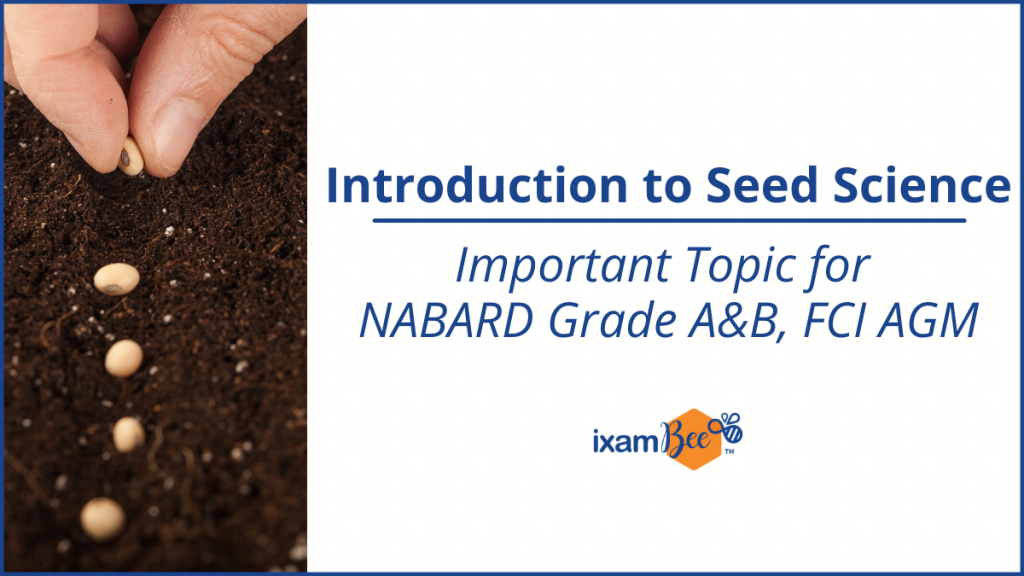In agricultural examinations such as NABARD Grade A and FCI AGM, meticulous preparation is imperative, and candidates cannot afford to underestimate the importance of key subjects outlined in the syllabus. One such pivotal topic in the Agricultural and Rural Development section is “Introduction to Seed Science.” This subject is the cornerstone of agricultural practices, encompassing a spectrum of knowledge critical for aspirants aiming to ace these competitive exams.
Seed Science holds multifaceted relevance, spanning from the intricacies of seed germination to the diverse classification of seeds based on various parameters. Aspirants need a comprehensive understanding of these fundamental aspects to navigate the exam questions effectively. This blog aims to guide candidates by exploring seed science in-depth, shedding light on its nuances and intricacies. Throughout the course of this article series, we will unravel the layers of seed science, touching upon the scientific principles governing seed development, the role of genetics, and the broader implications of seed technology in contemporary agriculture. The content will not only be confined to theoretical knowledge. Still, it will also offer practical insights, aligning aspirants with the practical applications of seed science in the real-world agricultural landscape.
By delving into this topic, aspirants can fortify their foundation in agriculture, creating a solid platform for tackling questions related to seed science in the forthcoming exams. Let’s embark on this enlightening journey, cultivating a profound understanding of seed science that will undoubtedly contribute to exam success and proficiency in agriculture.
Definition of Seed Science
A seed, a paramount component in the life cycle of plants, serves as a reservoir for the embryonic plant or miniature plant. Functioning as a means of reproduction for all plant species, seeds play a pivotal role in perpetuating plant life. A distinctive characteristic lies in the structural variations between gymnosperms and flowering plants concerning seed protection. In the case of gymnosperms, seeds are exposed to the external environment, lacking the safeguard of a structure like the fruit. This exposure, while distinct, contrasts with flowering plants, where seeds find protection within a specialized structure called the fruit. The fruit serves as a shield, encapsulating and safeguarding the seed from external threats or detrimental factors.
The potential for new plant generation lies dormant within the seed, awaiting the conducive environmental conditions for activation. These conditions encompass a range of factors, including optimal temperature, humidity, and other critical elements. Once subjected to these favorable conditions, the seed undergoes germination, initiating the development of a new plant. This inherent capability underscores the resilience and adaptability embedded in seeds, making them integral to the perpetuation and evolution of plant life across diverse ecosystems.

Difference Between Certified Seen and Truthful Labelled Seed.
Certified Seed and Truthful Labeled Seed exhibit distinctions in their certification processes and applicability within the seed industry. Certified seed voluntarily undergoes a rigorous certification process, assuring quality through oversight by certification agencies. This certification exclusively applies to notified kinds, demanding adherence to minimum field and seed standards. Rigorous testing for physical purity and germination is conducted, with samples carefully collected by seed certification officers to maintain stringent quality control.
In contrast, Truthful Labeled Seed imposes mandatory labelling requirements for both notified kinds and released varieties. The producing agency shoulders the responsibility for quality assurance, with seed inspectors exclusively designated to collect samples for stringent quality checks. This compulsory labeling framework extends a heightened level of accountability, ensuring accurate representation and strict adherence to specified standards for both notified and released seed varieties. By placing the onus on the producing agency and designating seed inspectors for quality assessment, the process aims to uphold transparency, reliability, and adherence to established benchmarks in the labeling of seeds across the industry.
| Criteria | Certified Seed | Truthful Labeled Seed |
| Certification Process | Voluntary, certified by an agency | Compulsory labeling by producing agency |
| Applicability | Applicable to notified kinds only | Applicable to both notified and released varieties |
| Standards | Must meet minimum field and seed standards | Guarantees quality by producing agency |
| Testing | Tested for physical purity and germination | Quality checks performed by seed inspectors |
| Sample Collection | Seed certification officer and inspectors | Solely seed inspectors |
Seed Classification as Per Freezing Method
Seeds can be classified into two distinct categories based on their response to freezing conditions: Orthodox Seeds and Recalcitrant Seeds, also known as Unorthodox Seeds. Orthodox Seeds exhibit a remarkable ability to endure freezing temperatures, surviving in a dormant state. This adaptability allows them to withstand prolonged periods of freezing and thawing without losing viability. On the contrary, Recalcitrant Seeds lack this tolerance and are highly susceptible to damage from freezing, often losing viability when subjected to cold temperatures. Understanding these freezing classifications is crucial for effective seed storage and preservation, aligning with the diverse needs of different plant species in various environmental contexts.
Orthodox Seeds
Orthodox seeds, often referred to as desiccation-resistant seeds, possess the unique characteristic of enduring extended storage durations without compromising their viability. These seeds, exemplified by numerous annual and biennial crops such as Citrus aurantifolia, Capsicum annum, and guava (Psidium guajava), can be efficiently dried to as low as 5% moisture content without incurring damage, and they exhibit remarkable resilience to freezing temperatures. The synergy between low moisture levels and freezing conditions contributes to an extended lifespan for orthodox seeds, making them well-suited for ex-situ conservation without significant challenges.
Noteworthy examples, like the 2000-year-old Judean date palm seed successfully germinated in 2005 after accidental storage followed by controlled germination, underscore the remarkable longevity potential of orthodox seeds. While the lifespan of these seeds can vary from over a year to several hundred years, the upper limit remains uncertain, emphasizing the need for ongoing research into the maximum survival time of properly stored orthodox seeds. This intricate interplay between moisture content, freezing tolerance, and extended viability underscores orthodox seeds’ significance in preserving plant species’ genetic diversity.
Recalcitrant Seeds (Unorthodox Seeds)
Recalcitrant seeds, also known as desiccation-responsive seeds, stand in stark contrast to their orthodox counterparts due to their notably brief lifespan and inherent inability to endure low moisture levels or freezing conditions. Unlike orthodox seeds, recalcitrant seeds cannot be dried to a moisture content below 20-30% without suffering damage, and they lack the resilience to withstand freezing temperatures. These characteristics pose significant challenges to the effective storage and ex-situ conservation of recalcitrant seeds.
The high moisture content in recalcitrant seeds makes them prone to microbial contamination and accelerates seed degradation. Freezing these seeds leads to the formation of ice crystals, causing damage to cell membranes and freezing injury. Consequently, storing plants containing recalcitrant seeds necessitates maintaining them in the growing phase, propagating vegetatively to preserve their genetic material effectively.
Recalcitrant species are often found among trees and shrubs in tropical, moist temperate, and certain aquatic environments. Examples include avocado, cacao, coconut, jackfruit, lychee, mango, rubber, tea, horticultural trees, and plants used in traditional medicine. Their inherently short life span further complicates conservation efforts, with some species losing viability within a week when exposed to air, emphasizing the urgency in addressing the unique challenges posed by recalcitrant seeds in seed storage and preservation.
Intermediate Seeds
Several seeds exhibit characteristics that defy strict categorization into orthodox or recalcitrant classes, forming an intermediate category. Certain seeds display resilience to desiccation but remain susceptible to freezing temperatures, introducing a nuanced dimension to seed classification. Notably, seeds from citrus and coffee exemplify this intermediate nature, embodying a unique combination of traits that challenge conventional categorizations. Unlike orthodox seeds, these intermediates can withstand partial drying but lack the robust freezing tolerance associated with true orthodox seeds. The existence of such intermediate seeds underscores the intricate variability within the plant kingdom and necessitates a more nuanced understanding of seed behavior for effective conservation and storage practices. As scientists delve deeper into the complexities of seed characteristics, the identification and classification of seeds continue to evolve, contributing to the refinement of seed preservation strategies.
Seeds Isolation Distance
In seed production, ensuring the genetic purity of crops is imperative, necessitating the implementation of isolation distances between fields of the same crop species. This precaution, known as the isolation distance, varies according to the specific crop and prevents undesirable pollination from foreign pollen. In cross-pollinated and often cross-pollinated plants and self-pollinated species susceptible to mechanical mixture, isolation is crucial. The required isolation distance ranges from 3 meters for self-pollinated crops like wheat and rice, to 200 meters for maize, bajra, and jowar, and even extends to 400 meters in the case of jowar when isolated from Johnson grass (Sorghum halepense). These varying isolation distances reflect the diverse pollination mechanisms and reproductive strategies employed by different crop species in seed production. The minimum Isolation distance of different crops for seed production is given below:
| Crop | Foundation Seed (m) | Certified Seed (m) |
| Hybrid Maize | 400 | 200 |
| Hybrid Jowar | 300-400 | 200-400 |
| Hybrid Bajra | 1000 | 200 |
| Wheat | 3 | 3 |
| Rice | 3 | 3 |
| Cotton | 50 | 30 |
| Soybean | 3 | 3 |
| Rapeseed and Mustard | 400 | 200 |
| Groundnut | 3 | 3 |
| Sesame | 100 | 50 |
| Peas | 20 | 10 |
| Cowpeas, Sem, Rajma | 50 | 10 |
| Tomato | 50 | 20 |
| Bhendi | 400 | 200 |
| Chillies | 400 | 100 |
| Potatoes | — | 100 |
| Brinjal | 200 | 100 |
| Carrot | 1000 | 400-800 |
| Cucurbits | 800 | 400 |
| Radish and Turnip | 1600 | 1000 |
| Cauliflower | 1600 | 1000 |
Note: “-” denotes not applicable in the case of Potato for Foundation Seed. The ranges for Certified Seed in Carrot represent varying isolation distances depending on specific conditions.
Prepping for NABARD Grade A, FCI AGM and NABARD Grade B with ixambee
In NABARD Grade A, NABARD Grade B, and FCI AGM exams, a comprehensive understanding of seed sciences holds paramount importance. This falls under the domain of Agricultural and Rural Development, a crucial section in these competitive exams. A sound knowledge of seed sciences is instrumental for aspirants aiming to excel in topics related to crop production, agriculture, and rural development. Questions in this category can encompass seed classifications, breeding techniques, and the significance of certified seeds.
Given these exams’ focus on agricultural development and rural economy, a nuanced understanding of seed sciences becomes a key asset. This knowledge aids aspirants in comprehending sustainable agricultural practices, crop improvement strategies, and the role of certified seeds in enhancing productivity. As these exams assess candidates on multiple agricultural and rural development dimensions, mastering seed sciences contributes significantly to achieving a competitive edge in this domain. ixamBee provides prospective students with ample opportunities to prepare thanks to its comprehensive NABARD Grade A, FCI AGM, and NABARD Grade B Online Course. Students can also use other resources like NABARD Grade A, FCI AGM and NABARD Grade B Free Mock Tests and NABARD Grade A, FCI AGM and NABARD Grade B Previous Year Papers. Candidates can also use BeePedia for preparation.
Summing Up
A comprehensive understanding of seed sciences is pivotal for success in competitive exams such as NABARD Grade A, NABARD Grade B, and FCI AGM. The intricate knowledge of seed classifications, breeding techniques, and the significance of certified seeds is essential for navigating questions related to crop production, agriculture, and rural development. Mastering seed sciences contributes to exam success and enhances proficiency in sustainable agricultural practices. Aspirants can leverage resources like ixamBee’s Online Course, Free Mock Tests, and BeePedia to ensure thorough preparation and achieve a competitive edge.
To help you prepare 50% faster for competitive exams, ixamBee provides a free Mock Test Series and all the Current Affairs in English and Current Affairs in Hindi in the BeePedia capsules for GA Preparation. You can also get the latest updates for Bank PO, Bank Clerk, SSC, RBI Grade B, NABARD, and Other Government Jobs.
Also Read
English Important Questions for RBI Assistant and SBI Clerk
NABARD Grade A: Agriculture and Rural Development
NABARD Grade A Phase 2 Preparation: Sample Questions for Descriptive ARD















